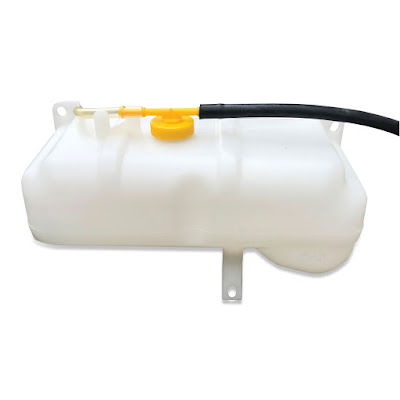Expand the Life of Your Engine: A Guide to Overflow Tank Replacement
You are in need of a replacement of your overflow tank if the cooler is leaking underneath your vehicle or in cases when the coolant sensor remains “on” all the time. When the time comes, you need to be informed about what to do. Here are a few tips and steps that will guide you through the process.
Step 1: Prepare the Vehicle – The location of the coolant reservoir is on top of the engine compartment, and in some instances, it may be tucked below. Regardless of the exact position, the universal overflow tank is easy to reach and you won't need to jack up the car or place it on a vehicle lift. It is recommended that you place a bucket under the tank. You will need it if there are remains of coolant in the tank and it starts leaking once you remove it.
Step 2: Protect any Rusted Bolts – You need to make sure that the bolts that secure the tank are not rusted. But, in most cases, these parts are either severely rusted or difficult to remove because of the constant contact with water, coolant and other liquids. Before beginning with the removal, make sure that you spray the bolts with a penetrating oil in order to reduce the risk of breaking a stud or stripping a nut. You should leave the spray to settle for about 5 minutes, and after that, you can try and remove the rusted bolts or nuts.
Step 3: Remove the Top Hoses – After you remove the bolts and nuts that secure the tank, next thing you need to do is to remove the two top hoses that have clamps attached to them. Make sure that you properly remove these before you continue to the next step. Close the teeth of the clamps, if they have the teeth clamp system, or unscrew the clamp with a flat screwdriver if that is the type of clamp that your car has. Next, you need a flat head screwdriver to carefully pry the hose clamps off their fitting.
Step 4: Remove the Bottom Hose – You can find a larger circumference coolant hose that runs to the radiator and it is located on the bottom of the universal overflow tank. Using the same technique as step 3, loosen the clamp and slide it down until it is far enough from the connection.
Step 5: Remove the Rear Clip – Most universal overflow tanks come with a clip that secures the reservoir to the rear of the engine compartment. There will be a metal strap that holds the tank to the compartment, and in order to remove it you need to slide the screwdriver in between the tank and the clip and pry forward. The clip will pop off effortlessly, and after that, the universal overflow tank is loose and ready to be removed.
Step 6: Clean the Area – When you remove the tank, you should clean all coolant, debris, dirt or gunk that may be left there. The area should be clean before you reinstall the new part. Also, clean all the connections and hoses, so that the installation can go smoothly and without any trouble.
Step 7: Reinstall the New Tank – First of all, before continuing with the procedure, you need to make sure that the new tank has the same features, size and fittings as the old one. Then you can finish the installation process.
Step 8: Reattach the Parts – The previously removed hoses and clamps need to be properly and carefully reattached, and the new tank should be secured with bolts to the engine compartment. Lastly, once you are done, you can fill the tank with a coolant and take your vehicle on a test drive.
Step 1: Prepare the Vehicle – The location of the coolant reservoir is on top of the engine compartment, and in some instances, it may be tucked below. Regardless of the exact position, the universal overflow tank is easy to reach and you won't need to jack up the car or place it on a vehicle lift. It is recommended that you place a bucket under the tank. You will need it if there are remains of coolant in the tank and it starts leaking once you remove it.
Step 2: Protect any Rusted Bolts – You need to make sure that the bolts that secure the tank are not rusted. But, in most cases, these parts are either severely rusted or difficult to remove because of the constant contact with water, coolant and other liquids. Before beginning with the removal, make sure that you spray the bolts with a penetrating oil in order to reduce the risk of breaking a stud or stripping a nut. You should leave the spray to settle for about 5 minutes, and after that, you can try and remove the rusted bolts or nuts.
Step 3: Remove the Top Hoses – After you remove the bolts and nuts that secure the tank, next thing you need to do is to remove the two top hoses that have clamps attached to them. Make sure that you properly remove these before you continue to the next step. Close the teeth of the clamps, if they have the teeth clamp system, or unscrew the clamp with a flat screwdriver if that is the type of clamp that your car has. Next, you need a flat head screwdriver to carefully pry the hose clamps off their fitting.
Step 4: Remove the Bottom Hose – You can find a larger circumference coolant hose that runs to the radiator and it is located on the bottom of the universal overflow tank. Using the same technique as step 3, loosen the clamp and slide it down until it is far enough from the connection.
Step 5: Remove the Rear Clip – Most universal overflow tanks come with a clip that secures the reservoir to the rear of the engine compartment. There will be a metal strap that holds the tank to the compartment, and in order to remove it you need to slide the screwdriver in between the tank and the clip and pry forward. The clip will pop off effortlessly, and after that, the universal overflow tank is loose and ready to be removed.
Step 6: Clean the Area – When you remove the tank, you should clean all coolant, debris, dirt or gunk that may be left there. The area should be clean before you reinstall the new part. Also, clean all the connections and hoses, so that the installation can go smoothly and without any trouble.
Step 7: Reinstall the New Tank – First of all, before continuing with the procedure, you need to make sure that the new tank has the same features, size and fittings as the old one. Then you can finish the installation process.
Step 8: Reattach the Parts – The previously removed hoses and clamps need to be properly and carefully reattached, and the new tank should be secured with bolts to the engine compartment. Lastly, once you are done, you can fill the tank with a coolant and take your vehicle on a test drive.




Comments
Post a Comment